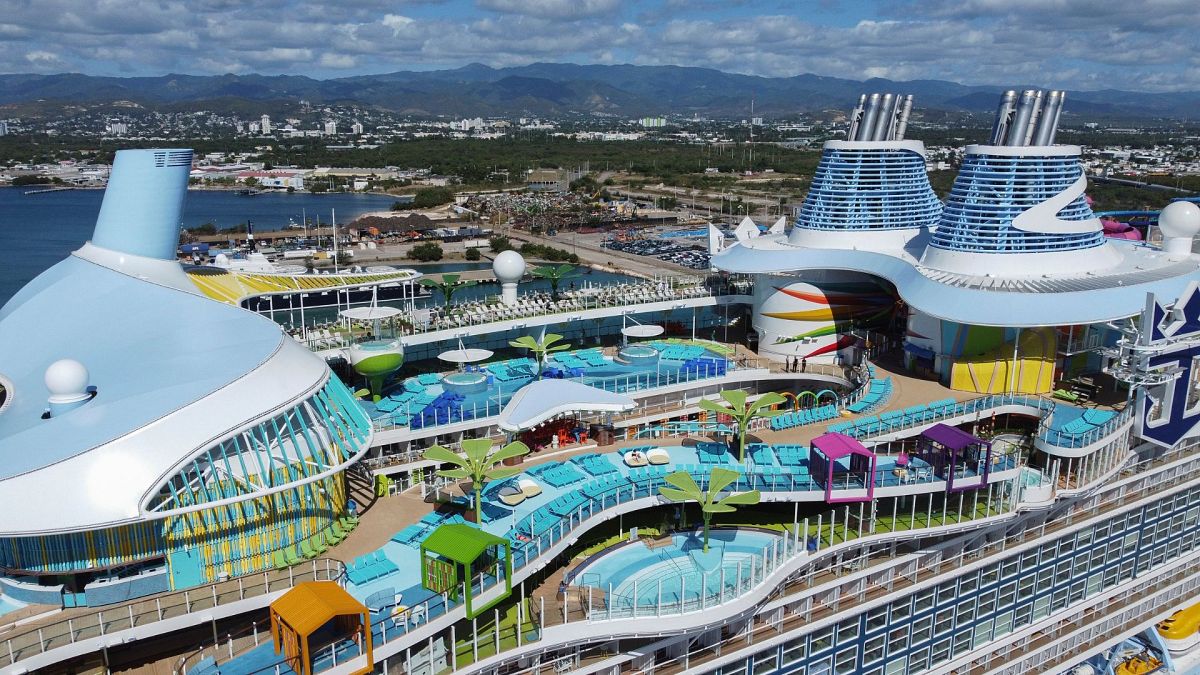Despite carrying 36 million passengers a year, cruise ships are currently exempt from fuel duties and most consumer taxes.
Five times larger than the Titanic, the Icon of the Seas was unveiled at the start of 2024 as the world’s biggest cruise ship.
It highlights a spiralling trend in the industry: the largest cruises have more than doubled in size since the year 2000.
If this trajectory continues, ships could grow to a whopping eight times the size of the Titanic by 2050.
They’d make the 10-deck, 269-metre-long ship from 1912 “look like a fishing boat”, according to a new report titled ‘Cruisezillas: How much bigger can cruise ships get?’ released by Transport & Environment (T&E) today.
In the report, T&E calls for faster and more stringent climate requirements to be placed on cruise ships, as well as full and transparent disclosure of their emissions.
“Cruise ships spend considerably more time in ports than other ship types and cause immediate health risks to the human population and nature,” the report reads.
“Considering their luxury status and extensive greenwashing practices, cruise companies should be required to lead shipping’s decarbonisation efforts and deliver on their green claims.”
‘Cruisezilla 2050’: How big could cruise ships get?
The Titanic had capacity for 2,500 passengers and had a gross tonnage (GT) – or volume – of 46,300.
Icon of the Seas blows this out the water with a 7,600 capacity and 248,700 GT. Across 20 decks, it features seven pools, a waterpark and more than 40 bars and restaurants spread across eight ‘neighbourhoods’.
By 2050, if cruises keep growing at the rate of the past 20 years, T&E predicts that the largest ships could carry 10,500 passengers with a GT of 345,000.
The number of ships at sea has also increased exponentially in recent decades, growing by 20 times from 22 ships in 1970 to 521 today.
‘Out of control’: Is it time for a crackdown on cruise emissions?
Bigger ships, and more of them, mean higher emissions: despite the pandemic, the CO2 output from cruises in Europe grew by 17 per cent between 2019 and 2022, while methane emissions rocketed by 500 per cent.
Grassroots campaigns have sprouted in Europe and beyond to stem the tide of cruising, and some port cities have introduced their own restrictions.
In 2021, Venice, Italy, barred large cruise ships from anchoring in its historic centre, while Palma de Mallorca and Barcelona in Spain have capped the number of cruise ships allowed in daily. Amsterdam, too, recently announced plans to ban cruise ships from its city centre by 2035.
But are these restrictions enough?
“The cruise business is the fastest growing tourism sector and its emissions are quickly getting out of control,” says Inesa Ulichina, sustainable shipping officer at T&E.
“Cruising is a luxury business and operators must take responsibility for their climate impact. If they want to avoid becoming increasingly unwanted visitors, they must clean up their act.”
What’s needed to keep polluting cruise ships in check?
T&E notes that cruise ships are currently exempt from fuel duties as well as most corporate and consumer taxes.
With nearly 36 million holidaymakers projected to take a cruise voyage in 2024, adding a €50 tax on cruise tickets would bring in €1.6 billion globally – and €410 million in Europe alone.
These funds could be used to decarbonise the industry, for example by investing in hydrogen-based e-fuels.
E-fuels have the potential to power 4 per cent of EU shipping by 2030, according to T&E’s report.
Some financial incentives are already in place to speed up this transition.
EU regulations introduced this year place large ships (over 5,000 GT) entering the bloc under the Emissions Trading System. This forces companies to buy allowances to emit CO2, with heavy fines issued if they do not have enough of these to cover their output. The allowances are capped across industries.
From 2026, it will also apply to methane and nitrous oxide emissions, with the caps gradually lowered over time.
Penalties for using dirty marine fuels will also progressively increase from 2025 under the FuelEU Maritime scheme.
Thanks to these measures, T&E estimates that by 2030 a seven-day cruise sailing on fossil fuels would pay almost €144,000 more in fuel and penalty costs than those blending small amounts of e-methanol made from renewable hydrogen into their fuel mix.
As regulations tighten, this could rise to nearly €400,000 by 2030 and €1.3 million by 2050 for every week sailed.

